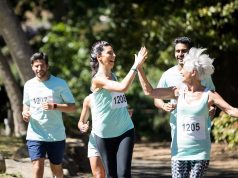The American College of Sports Medicine’s 64th Annual Meeting and 8th World Congress on Exercise is Medicine
The annual meeting of the American College of Sports Medicine was held from May 30 to June 3 in Denver and attracted more than 6,000 participants from around the world, including clinicians, academicians, allied health professionals, and others interested in sports medicine. The conference highlighted recent advances in exercise science and sports medicine, with presentations focusing on the advancement and integration of scientific research to improve clinical practice.
In one presentation, Daheia J. Barr-Anderson, Ph.D., of the University of Minnesota in Minneapolis, discussed how wearable devices, high-intensity interval training, and yoga have been used to increase physical activity in African-American and Hispanic populations.
“Wearable technology has been found to make a positive impact on increasing physical activity and it offers abundant opportunities to promote physical activity and health in minority communities,” Barr-Anderson said. “High-intensity interval training in minority communities can provide structure for individuals to increase their dose of exercise within a given period of time. It may also be a more gradual, ‘user-friendly’ way to introduce vigorous activity into previously sedentary populations.”
According to Barr-Anderson, yoga programs have been delivered that have improved a variety of outcomes in chronically ill individuals. “Improvements have included increased quality of life and well-being, lower distress, improved flexibility, oxygen consumption, inflammatory biomarkers, reduced weight, improved depressive symptoms, improved interpersonal relationships, decreased stress and sedentary time, and increased physical activity,” Barr-Anderson said. “Currently, only 6 percent of people who practice yoga reported that it was recommended by their doctor or therapist. If physicians are seeking innovative and new ways to engage their minority patients, they should recommend yoga.”
Session No. A-31
Beth Taylor, Ph.D., of the University of Connecticut in Storrs, performed a systematic review of all randomized clinical trials regarding the acute and chronic effects of resistance or aerobic exercise on cardiometabolic disease biomarkers (cholesterol, blood pressure, glucose, insulin).
Taylor believes that the effect of exercise on cardiometabolic risk is likely underestimated, since most studies may not have been adequately powered for their outcomes, and sample sizes were too small.
“The science of exercise prescription for disease prevention is made less successful due to significant heterogeneity in both the methods and results of exercise training studies. For example, of all the exercise studies we assessed, no study was adequately powered to detect the effect of exercise training on low-density lipoprotein cholesterol, and less than a third were adequately powered to assess the impact of exercise on blood pressure and blood glucose,” Taylor said. “Moreover, the methods of these studies have been widely variable, often lacking key factors such as a control group, standardized protocols, details about the exercise training intervention, and standardized measurements. Therefore, the clinical use of exercise prescription could be improved by strategies to better design, assess, and analyze exercise data.”
Session No. B-58
In another presentation, Brian Focht, Ph.D., of The Ohio State University in Columbus, discussed the adverse effects of androgen-deprivation therapy (ADT) on prostate cancer patients, including increased risk for sarcopenic obesity, functional limitations, loss of muscular strength, cardiovascular disease, and metabolic syndrome.
“Results of our IDEA-P trial in 32 prostate cancer patients undergoing ADT revealed that a combined exercise and diet lifestyle intervention reversed or attenuated a variety of the declines in functional, body composition, and muscular strength outcomes in these patients,” Focht said. “Integrating lifestyle interventions into the treatment of prostate cancer can offset many of the adverse effects of ADT for these patients.”
Session No. B-38
ACSM: Compression Tights Don’t Improve Performance for Runners
FRIDAY, June 2, 2017 (HealthDay News) — Compression tights are not effective in reducing fatigue in runners, according to a study presented at the annual meeting of the American College of Sports Medicine, held from May 30 to June 3 in Denver.
Copyright © 2017 HealthDay. All rights reserved.







